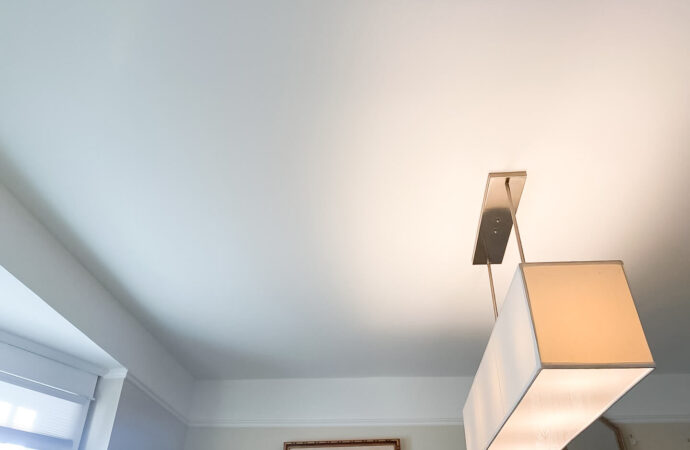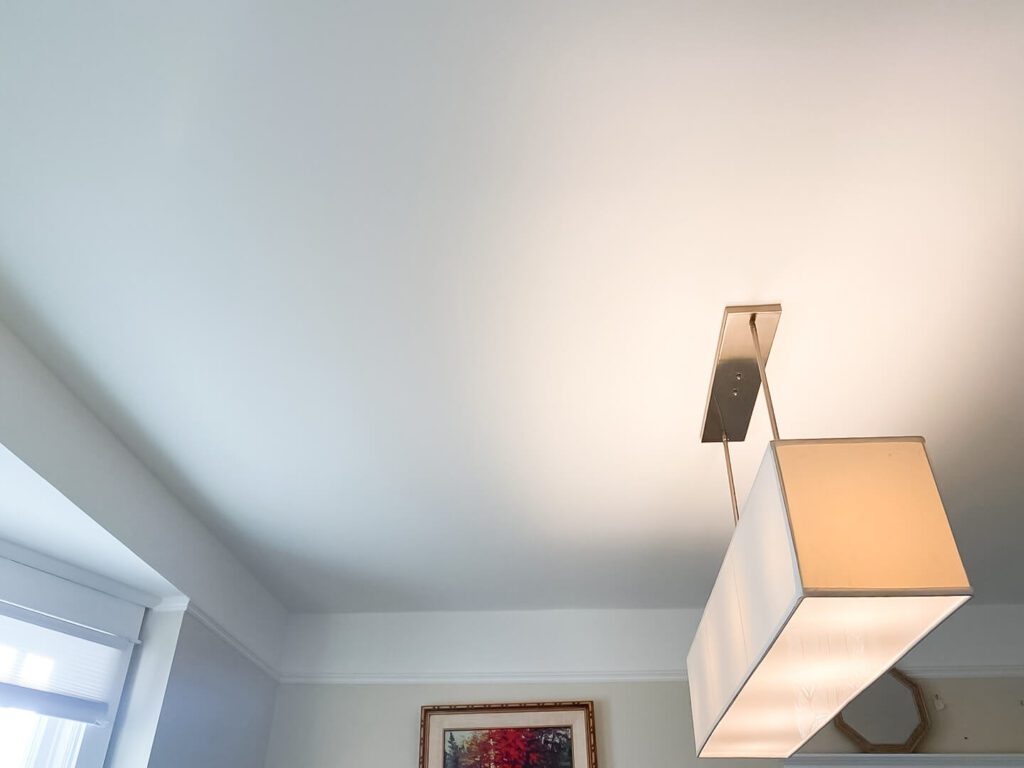Ceiling painting is more complicated than painting walls. This is due to the awkward nature of working above the ceiling and the possibility of drips and mess throughout the room. Finishing this job is possible if you prepare well and invest in the right tools. When painting an entire room, the ceiling should be painted first. This will ensure that any paint spilled elsewhere in the room won’t damage a fresh coat of paint. In an ideal world, you’d be able to move all of your furniture out of the space. This will protect it from paint drips and give you complete control over the space to paint the ceiling. This is not always possible. You can move furniture to one side and cover it with dust sheets. To prevent paint from getting on carpets, floorboards, or tiles, you will need dust sheets or another floor protector. If your ceiling is not smooth and you have only applied a few coats, you can brush it over to remove any cobwebs, dust, and debris. To clean and degrease the ceiling if it is stained, which often happens in a kitchen. This can be done with a kitchen scrub pad. Rub the paint down with sandpaper to remove any imperfections or to peel. You can also use a sanding stick for speed. Fill any cracks or holes with the appropriate filler product, then rub them down once dry. This will give the paint a smoother surface and more adhesion. Water-based emulsion paint will not cover watermarks and stains correctly. To cover watermarks or stains, use a specialist stain blocker. Use this instead of an oil-based gloss or undercoat. This will prevent watermarks/stains from seeping through your ceiling and ruining it. You can remove a ceiling rose simple pendant fitting and slide it down. Cover the fitting. You can also use painter’s tape to cover the edges of the light fitting closest to the ceiling. You can repeat the procedure until you have doubled the tape width and covered more of the fitting. If you can, turn off the electricity while you paint to be safe. How to prepare a textured ceiling. Use a stiff brush to brush the ceiling. To avoid climbing up on a ladder, you can use a broom to sweep the ceiling. It cannot be easy to paint around textured ceiling edges. Tape is not an option. Instead, use a small paint brush (1-2 inches) to scrape along the ceiling’s length. This will create a smoother surface, making it easier to paint straight lines. Different ceilings require different application methods. It is easy to paint a ceiling that has been previously painted smooth. Which paint brush or roller is best for this type of ceiling? You will need a 2 to 4-inch brush to cut the ceiling and a 9 to 11-inch roller to apply paint. A specialist segmented foam roller can be used to paint ceilings with simple textures or aertexes. It is a multi-slit foam roller that covers the entire surface. To reach all smooth ceiling crevices, you can use a block brush and a 4-inch emulsion brush. Ceilings that have been freshly plastered are now different. Allow them to dry for at least 4-6 weeks before painting. A mist coat is the first thing you should do when installing a plaster ceiling. This is a watered-down emulsion. A white emulsion is cheaper than colored and can be used as a base for any color. Mix three parts of paint and one part of water together, and then use a roller to apply the emulsion. Be aware of runs. One of the corners is the best place to begin a ceiling. Although it is not necessary, it makes a great focal point. First, cut around light fittings and the ceiling edges. You should first trim all four corners of the space before you begin rolling the ceiling. A border should be created around the ceiling edge, approximately 3-4 inches in width. You don’t have to cut the walls if you are painting them. This can be done when you paint the walls. However, ensure to overlay ceiling paint about 2 inches on the wall to provide a base for the wall color. After you’ve painted a section of the surface, use the roller to go over it again – without any paint and with a lighter touch. This will remove any streaks, drips, or lines. Continue this process until all color is gone. This should be done while the paint is still damp. A ceiling can be painted with two coats of emulsion. If the ceiling is newly plastered, you may need another coat. The drying time for emulsions is typically between 2 and 4 hours. Make sure to check your paint before you apply it. This gives you plenty of time for a second coat to be used on the same day. You can have your ceiling completed by noon if you start early. It’s almost impossible to repair small patches of texture once you have painted the ceiling. It’s easy to get rid of the old texture. However, it can be messy if you have to sand it off. Use a drywall power tool with an attached dust collection bag to sand the old texture. Even without the bag attached, you can remove the texture and disperse drywall dust from the room. You can move the power sander side to side and sand in swathes approximately 4 feet across, starting at one end of your ceiling, then moving back. The dust in the air can cause blurred vision to the ceiling after a few seconds. The dust collection bag should be changed or emptied frequently. The bag can hold a small amount of drywall dust from sanding newly taped seams. However, the bulk of the dust created by sanding textured ceilings will quickly fill the bag. After you have finished sanding the ceiling, let the dust settle and resend any areas you missed. Warm water can be added to a pump sprayer. Spray a 3-foot area with the sprayer, just enough to dampen it. The water will absorb quickly into the texture. Allow the compound to dry for five minutes before using the pole scraper. The thickness and type of ceiling paint will determine whether the old texture will come off quickly or not. Respray the area and wait five minutes before testing the texture. Follow the same process of applying water to the ceiling and then scraping it. If the texture is difficult to squeeze after thoroughly wet, you will need to sand it. Take out any furniture or other objects from the room and cover them with drop cloths. You will need a complete respirator mask with interchangeable filters and goggles to seal your eyes. If you do not apply a skim-coat joint compound, the drywall underneath the old texture might not be suitable for flat ceilings. Boynton Beach Popcorn Ceiling Removal & Drywall Contractors will spend less time taping and mudding ceilings with texture. Therefore, removing the old texture doesn’t guarantee a flat ceiling. These are some of the questions you will ask yourself if you’re considering renovating your home. You do not need to buy two types of paint when you can use one on your ceilings and walls. Technically, ceiling paint can be used on walls and vice versa. However, it is not so simple. It is crucial to prepare for the process beforehand. Let’s compare the differences between ceiling and wall paint. For obvious reasons, any paint you apply to the ceiling must not be too thin. If you apply thin wall paint to the ceilings, you should be ready for drips and spills on your carpets, floors, and hands. Ceilings are significant because paint consistency is crucial. Otherwise, you will need to spend a lot more time cleaning up. High viscosity paints are preferred for ceiling painting. Higher viscosities produce fewer drips when applying paint. It depends on what type of ceiling paint you use. However, some options dry faster than others. Ceiling paint allows you to experiment with different textures and finishes without worrying about it. Because thicker paint materials can hold textures in place more quickly, These paints last longer than regular paints and don't crack or peel at the edges. Both oil-based and water-based options are available. They will last for many ceilings. Ceiling paints are generally limited in color, so finding unique shades at your local store may be challenging. It is easy to find basic shades such as pale blue, pale pink, and white latex paint. Other than a few colors, there are not many other options. Some brands make very light colors that dry white. Do a test patch first to get an idea of the final result. You can mix wall paint with ceiling paint to achieve a lighter shade. We offer the above services at the following locations within Boynton Beach:
If you are located in Palm Beach County and you don’t see your city/area listed above, don’t worry! We cover all of Palm Beach County. Fill out the contact form above or CLICK HERE and send us a message. We’ll get back to you asap!
Smooth Ceiling Finish
Contact Us

Cover your room to keep splashes out
Sand the surface
Stains can be removed.
Advertisement
Keep your lights clean.
How do you paint a ceiling?
Advertisement
How do you start painting a ceiling?
How many layers of paint does a ceiling need?
Sanding
Scraping
Allow the texture to dry before you apply a new surface.
Can you use ceiling paint and wall paint interchangeably?
Viscosity
Durability
Colors
Locations We Serve

